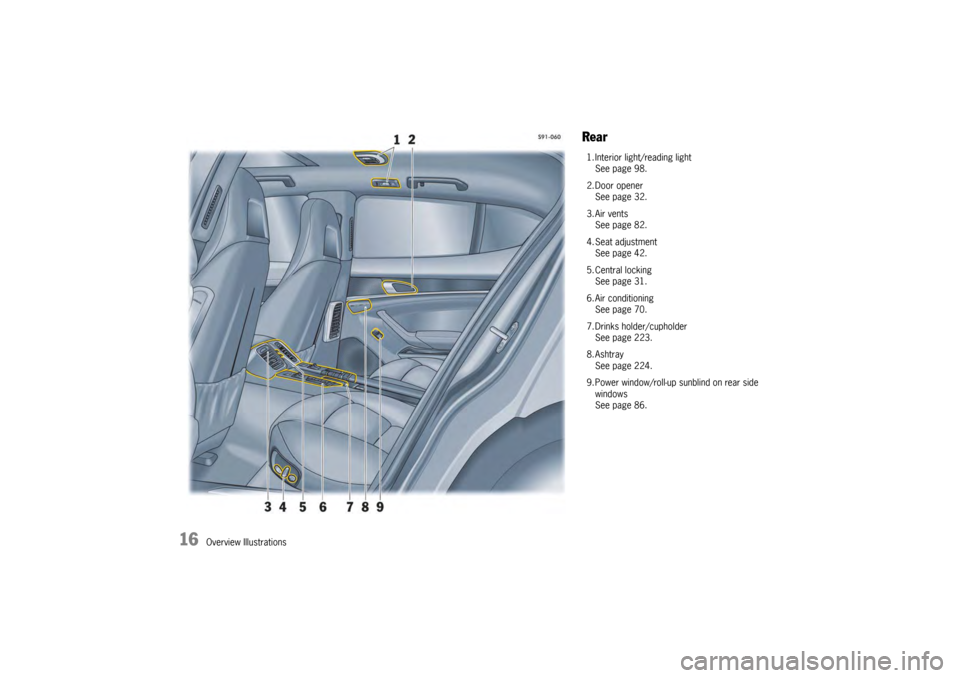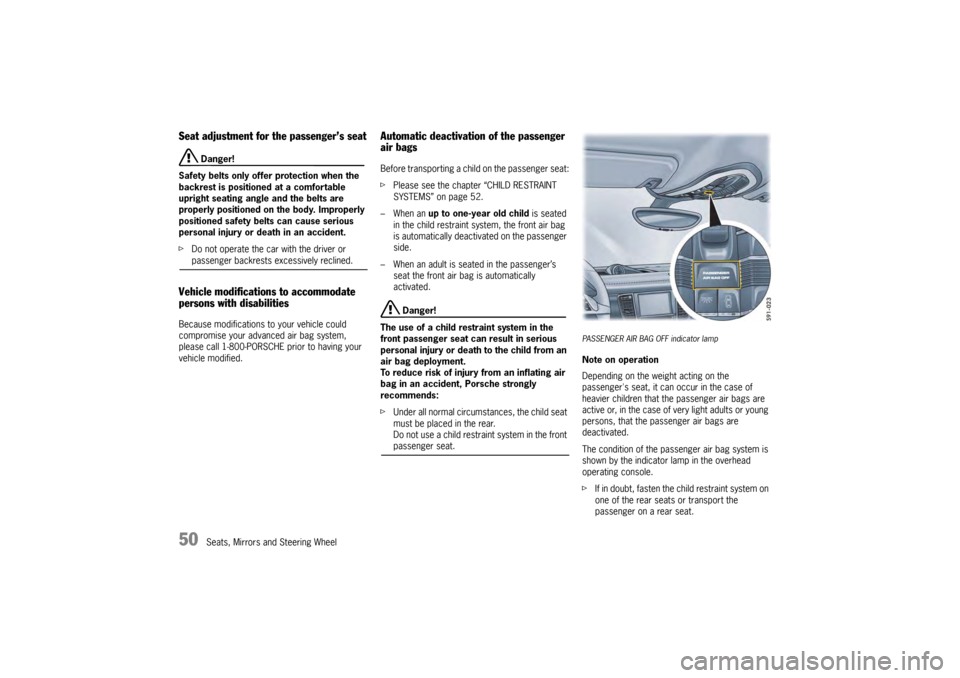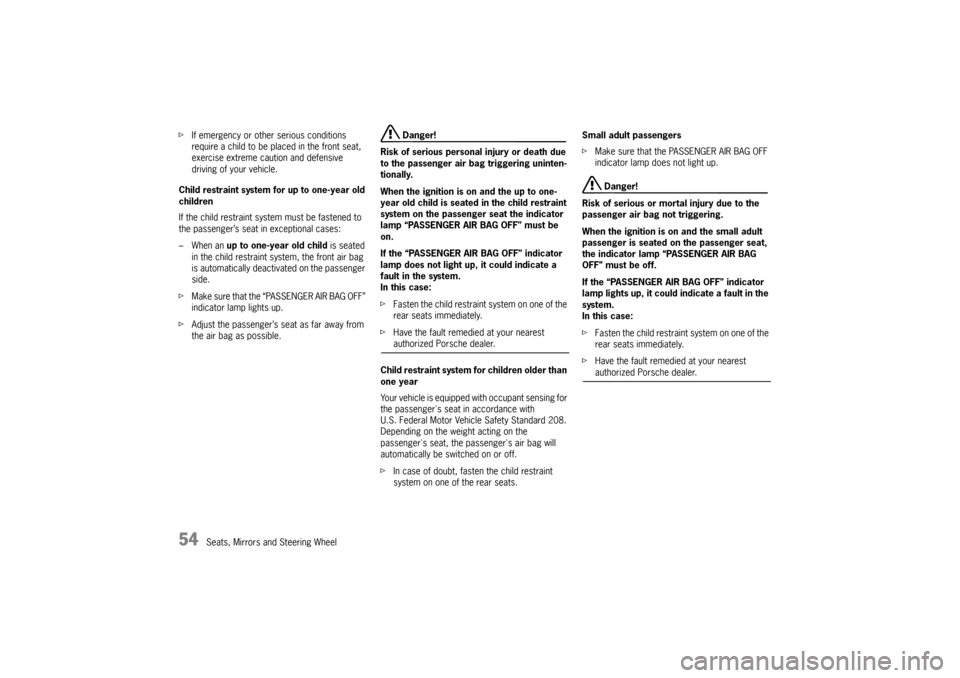2009 PORSCHE PANAMERA air condition
[x] Cancel search: air conditionPage 4 of 343

2Throughout this booklet, left is designated as the
driver's side of the vehicle, and right as the
passenger's side of the vehicle.
Text, illustrations and specifications in this manual
are based on the information available at the time
of printing.
It has always been Porsche’s policy to continu-
ously improve its products. Porsche, therefore,
reserves the right to make changes in design and
specification, and to make additions or improve-
ments in its product wi thout incurring any obliga-
tion to install them on products previously manu-
factured.
We wish you many miles of safe and pleasurable
driving in your Porsche.
Important!
For your own protection and longer service life of
your car, please heed all operating instructions
and special warnings. These special warnings use
the safety alert symbol, followed by the words
Danger, Warning and Caution . These special
warnings contain important messages regarding
your safety and/or the potential for damage to
your Porsche. Ignoring them could result in
serious mechanical failure, serious personal injury
or death. f
Do not alter your Porsche. Any alteration could
create dangerous conditions or defeat safety
engineering features built into your car.
f Do not misuse your Porsche. Use it safely, and
consistently with the law, according to the
driving conditions, and the instructions in this
manual.
Alteration or misuse of your Porsche could
cause accidents and seri ous personal injury
or death.
Note to ownersIn Canada, this manual is also available in French.
To obtain a copy contact your dealer or write to:Note aux proprietairesAu Canada on peut se procurer un exemplaire de
ce Manuel en français auprès du concessionaire
ou du:
Porsche Cars Canada, Ltd.
Automobiles Porsche Canada, LTEE
5925 Airport Road
Suite 420
Mississauga, Ontario
Canada, L4V 1W1
Telephone number for customer assistance:
1-800-PORSCHE / Option 3
Setting and operating vehicle compon-
ents when driving
Warning!
There is a danger of accident if you set or
operate the on-board computer, radio,
navigation system, telep hone or other equip-
ment when driving.
This could distract you from the traffic and
cause you to lose control of the vehicle
resulting in serious personal injury or death.
f Operate the components while driving only if
the traffic situation allows you to do so safely.
f Carry out any complicated operating or setting procedures only with the vehicle stationary.
Engine Exhaust
Danger!
Engine exhaust is dangerous if inhaled.
Engine exhaust fumes have many compo-
nents which you can smell. They also contain
carbon monoxide (CO), which is a colorless
and odorless gas.
Carbon monoxide can cause unconscious-
ness and even death if inhaled.
f Never start or let the engine run in an en-
closed, unventilated area.
It is not recommended to sit in your car for
prolonged periods with the engine on and the car not moving.
Page 7 of 343

5
In the driver’s seat…fCheck operation of the horn.
f Position seat for easy reach of foot pedals and
controls.To reduce the po ssibility of injury from
the air bag deployment, you should always sit
back as far from the steering wheel as is
practical, while still maintaining full vehicle
control.
f Adjust the inside and outside rear view mirrors.
f Buckle your safety belts.
f Check operation of the foot and electric
parking brake.
f Check all warning and indicator lights with
ignition on and engine not running.
f Start engine and check all warning displays for
warning symbols.
f Never leave an idling car unattended.
f Lock doors from inside, especially with
children in the car to prevent inadvertent
opening of doors from inside or outside. Drive
with doors locked.
On the road…fNever drive after you have consumed alcohol
or drugs.
f Always have your safety belt fastened.
f Always drive defensively.
Expect the unexpected.
f Use signals to indicate turns and lane changes.
f Turn on headlights at dusk or when the driving
conditions warrant it.
f Always keep a safe distance from the vehicle in
front of you, depending on traffic, road and
weather conditions.
f Reduce speed at night and during inclement
weather.
Driving in wet weather requires caution and
reduced speeds, particularly on roads with
standing water, as the handling characteristics
of the vehicle may be impaired due to hydro-
planing of the tires.
f Always observe speed limits and obey road
signs and traffic laws.
f When tired, get well off the road, stop and take
a rest. Turn the engine off. Do not sit in the
vehicle with engine idling.
Please see the chapter “ENGINE EXHAUST” on
Page 2. f
When parked, always put the electric parking
brake on and put the PDK selector lever in
position P.
On hills also turn the front wheels toward the
curb.
f When emergency repairs become necessary,
move the vehicle well off the road. Turn on the
emergency flasher and use other warning
devices to alert other motorists. Do not park
or operate the vehicle in areas where the hot
exhaust system may come in contact with dry
grass, brush, spilled fuel or other flammable
material.
f Make it a habit to have the engine oil checked
with every refueling.
Page 9 of 343

Contents
7
Contents
Overview Illustrations......................... 10Driver’s Cockpit ...............................
............. 11
Steering Wheel and Inst rument Panel .............. 12
Dashboard .......................................... ......... 13
Front Center Console . ................................... 14
Overhead Operating Co nsole ......................... 15
Rear ............................................................ 16Opening and Locking ......................... 17Never invite car theft! . ................................... 18
Notes on the Key and Central Locking
System ......................... .............................. 19
Central Locking System ................................ 20
Brief Overview – Opening and Locking
From Outside................................... ............. 21
Opening and Locking From Outside ................ 22
Opening and Locking From Inside................... 31
Opening and Closing the Engine
Compartment Lid ........ .................................. 33
Malfunctions When Open ing and Closing ......... 35Seats, Mirrors and Steering Wheel ..... 37Seat Adjustment and Head Restraints ............. 38
Adjusting Front Seats . ................................... 39
Storing Vehicle Settin gs ................................ 40
Easy Entry Function .... .................................. 42
Adjusting Rear Seats ..................................... 42
Adjusting Passenger Seat From Rear.............. 43
Front and Rear Heated Seats ......................... 43
Front and Rear Seat Ventilation ...................... 44 Safety Belts..............
.................................... 44
Air bag Systems ....... .................................... 47
Child Restraint System s................................. 52
LATCH Child Seat Syst em.............................. 56
Exterior Mirrors ........ .................................... 58
Steering Wheel ......... .................................... 61
Heated steering whee l ................................... 61
Steering Wheel Adjust ment ............................ 62
Multi-Function Steering Wheel......................... 63
Sun Visors .................... ................................ 64
Vanity Mirror ............. .................................... 64
Roll-Up Sunblinds, Rear Side Windows ............ 65
Roll-Up Sunblind, Rear Window ....................... 66
Air Conditioning .... ............................ 67Brief Overview – Front Control Panel ........ 68
Brief Overview – Rear Control Panel
(4-Zone Air-Conditioning) ................................ 69
Overview of Air Conditioning .......................... 70
General Functions ..... .................................... 71
Automatically Controlled Air Conditioning ........ 76
Air Vents ........................................... ........... 82
Heated Rear Window/Exterior Mirror
Heating ............................................. ........... 84Windows and Slide/Tilt Roof............... 85Power Windows ............................................ 86
Slide/Tilt Roof........... .................................... 88
Lights, Turn Signals and
Windshield Wipers. ............................ 91Automatic Driving Light Assistant/
Adaptive Light System ................................... 92
Instrument lighting ....... ................................. 95
Turn Signal/High Beam/Headlight
Flasher Stalk........... ...................................... 96
Emergency Flasher ...... ................................. 97
Interior Lighting............................ ................. 98
Brief Overview – Windshield Wipers ............ 101
Windshield Wiper/Washer Stalk .................... 102Instrument Panel and
Multi-Function Display ..................... 105Instrument Panel USA Mo dels ...................... 107
Instrument Panel Canada Models.................. 109
Tachometer ..................... ........................... 110
Speedometer .................. ........................... 110
Multi-Function Display .................................. 110
Engine Oil Temperature Gauge ..................... 110
Coolant Temperature Gauge ........................ 110
Engine Oil Pressure Ga uge .......................... 111
Fuel Gauge .................. ............................... 111
Digital Speedometer .... ............................... 112
Upshift Prompt Indicato r .............................. 112
Odometer........................ ........................... 112
Reset Button for Trip Counter Display/
Brightness Setting for In strument Lighting.... 112
PDK Display for Selector-Lever Position/
Engaged Gear ................. ........................... 112
Battery/Alternator ........ ............................... 113
Page 16 of 343

14
Overview Illustrations
Front Center Console1. Heated seats, seat ventilationSee page 43.
2. Air conditioning See page 70.
3. Emergency flasher See page 97.
4. Central locking See page 31.
5. Heated rear window/external mirror heating See page 84.
6. “Sport”/“Sport Plus” modes See page 212.
7. Porsche Active Suspension Management (PASM)
See page 208.
8. High level See page 210.
9. Porsche Stability Management (PSM) See page 202.
10.Auto Start Stop function See page 169.
11.Roll-up sunblind on rear window/rear side windows
See page 66.
12.Sports exhaust system See page 214.
13.Retractable rear spoiler See page 214.
Page 18 of 343

16
Overview Illustrations
Rear1. Interior light/reading lightSee page 98.
2. Door opener See page 32.
3. Air vents See page 82.
4. Seat adjustment See page 42.
5. Central locking See page 31.
6. Air conditioning See page 70.
7. Drinks holder/cupholder See page 223.
8. Ashtray See page 224.
9. Power window/roll-up sunblind on rear side windows
See page 86.
Page 51 of 343

Seats, Mirrors and Steering Wheel
49
Function of the air bag systemAir bags are a supplemental safety system. Your
primary protection comes from your safety belts.
The front air bags are triggered during a frontal
collision of sufficient force and direction.
In the event of a side impact of corresponding
force, the side air bag on the impact side is
triggered.
The inflation process generates the amount of gas
required to fill the air bags at the necessary
pressure in fractions of a second.
Air bags help to protect the head and body, while
simultaneously damping the motion of the driver
and passenger in the impact direction in the event
of a frontal impact or side impact.
In order to help provide protection in severe
collisions which can cause death and serious
injury, air bags must inflate extremely rapidly.
Such high speed inflation has a negative but
unavoidable side effect, which is that it can and
does cause injuries, including facial and arm
abrasions, bruising and broken bones. You can
help minimize such injuries by always wearing your
safety belts.
There are many types of accidents in which air
bags are not expected to deploy. These include
accidents where the air bags would provide no
benefit, such as a rear impact against your
vehicle. Other accidents where the air bags are
designed not to deploy are those where the risk of
injury from the air bag deployment could exceed any protective benefits, such as in low speed
accidents or higher speed accidents where the
vehicle decelerates over a longer time. Since air
bag deployment does not occur in all accidents,
this further emphasizes the need for you and your
passengers to always wear safety belts.
Your vehicle is equipped with a crash sensing and
diagnostic module. This module will record the
use of the seat belt restraint system by the driver
and front passenger when the air bags and/or belt
tentioner are triggered.
Precondition for activating the restraint systems:
f
Ignition is switched on.
Advanced air bagYour vehicle is equipped with occupant sensing for
the passenger's seat in accordance with
U.S. Federal Motor Vehicle Safety Standard 208.
Depending on the weight, body positioning and
shape acting on the passenger's seat, the
passenger's air bag will automatically be switched
on and off.
Depending on the angle and force of impact, the
passenger's air bag which is switched-on will be
triggered during a collision.
Precondition for switching the passenger's air bag
on and off, depending on weight, body positioning
and shape:
fIgnition is switched on.
Danger!
Risk of serious personal injury or death due
to the passenger air bag not triggering.
Improper handling of occupant sensing can
unintentionally impair switching the
passenger's air bag off and on.
If the weight on the passenger's seat is
reduced significantly, e.g., by supporting
weight on the armrest, the passenger's air
bag can be switched off.
f Select an upright seat position, and do not
support weight on the armrests or lean out of
the window.
Always keep feet in the footwell while driving.
Do not put feet on the dashboard or the seat
area. Do not lean against the inside of the door
or outside the window while the vehicle is
moving.
f If a child restraint system is installed on the passenger’s seat, do not adjust the seat.
Page 52 of 343

50
Seats, Mirrors and Steering Wheel
Seat adjustment for the passenger’s seat
Danger!
Safety belts only offer protection when the
backrest is positioned at a comfortable
upright seating angle and the belts are
properly positioned on the body. Improperly
positioned safety belts can cause serious
personal injury or death in an accident.
f Do not operate the car with the driver or passenger backrests excessively reclined.
Vehicle modifications to accommodate
persons with disabilitiesBecause modifications to your vehicle could
compromise your advanced air bag system,
please call 1-800-PORSCHE prior to having your
vehicle modified.
Automatic deactivation of the passenger
air bagsBefore transporting a child on the passenger seat:
fPlease see the chapter “CHILD RESTRAINT
SYSTEMS” on page 52.
– When an up to one-year old child is seated
in the child restraint system, the front air bag
is automatically deactivated on the passenger
side.
– When an adult is seated in the passenger’s seat the front air bag is automatically
activated.
Danger!
The use of a child restraint system in the
front passenger seat can result in serious
personal injury or death to the child from an
air bag deployment.
To reduce risk of injury from an inflating air
bag in an accident, Porsche strongly
recommends:
f Under all normal circumstances, the child seat
must be placed in the rear.
Do not use a child restra int system in the front passenger seat.
PASSENGER AIR BAG OFF indicator lampNote on operation
Depending on the weight acting on the
passenger's seat, it can occur in the case of
heavier children that the passenger air bags are
active or, in the case of very light adults or young
persons, that the passenger air bags are
deactivated.
The condition of the passenger air bag system is
shown by the indicator lamp in the overhead
operating console.
f If in doubt, fasten the child restraint system on
one of the rear seats or transport the
passenger on a rear seat.
Page 56 of 343

54
Seats, Mirrors and Steering Wheel
f
If emergency or other serious conditions
require a child to be pl aced in the front seat,
exercise extreme caution and defensive
driving of your vehicle.
Child restraint system for up to one-year old
children
If the child restraint syst em must be fastened to
the passenger’s seat in exceptional cases:
– When an up to one-year old child is seated
in the child restraint system, the front air bag
is automatically deacti vated on the passenger
side.
f Make sure that the “PASSENGER AIR BAG OFF”
indicator lamp lights up.
f Adjust the passenger’s seat as far away from
the air bag as possible.
Danger!
Risk of serious personal injury or death due
to the passenger air bag triggering uninten-
tionally.
When the ignition is on and the up to one-
year old child is seated in the child restraint
system on the passenger seat the indicator
lamp “PASSENGER AIR BAG OFF” must be
on.
If the “PASSENGER AIR BAG OFF” indicator
lamp does not light up, it could indicate a
fault in the system.
In this case:
f Fasten the child restraint system on one of the
rear seats immediately.
f Have the fault remedied at your nearest authorized Porsche dealer.
Child restraint system for children older than
one year
Your vehicle is equipped with occupant sensing for
the passenger's seat in accordance with
U.S. Federal Motor Vehicle Safety Standard 208.
Depending on the weight acting on the
passenger's seat, the passenger's air bag will
automatically be switched on or off.
f In case of doubt, fasten the child restraint
system on one of the rear seats. Small adult passengers
f
Make sure that the PASSENGER AIR BAG OFF
indicator lamp does not light up.
Danger!
Risk of serious or mortal injury due to the
passenger air bag not triggering.
When the ignition is on and the small adult
passenger is seated on the passenger seat,
the indicator lamp “PASSENGER AIR BAG
OFF” must be off.
If the “PASSENGER AIR BAG OFF” indicator
lamp lights up, it could indicate a fault in the
system.
In this case:
f Fasten the child restraint system on one of the
rear seats immediately.
f Have the fault remedied at your nearest authorized Porsche dealer.